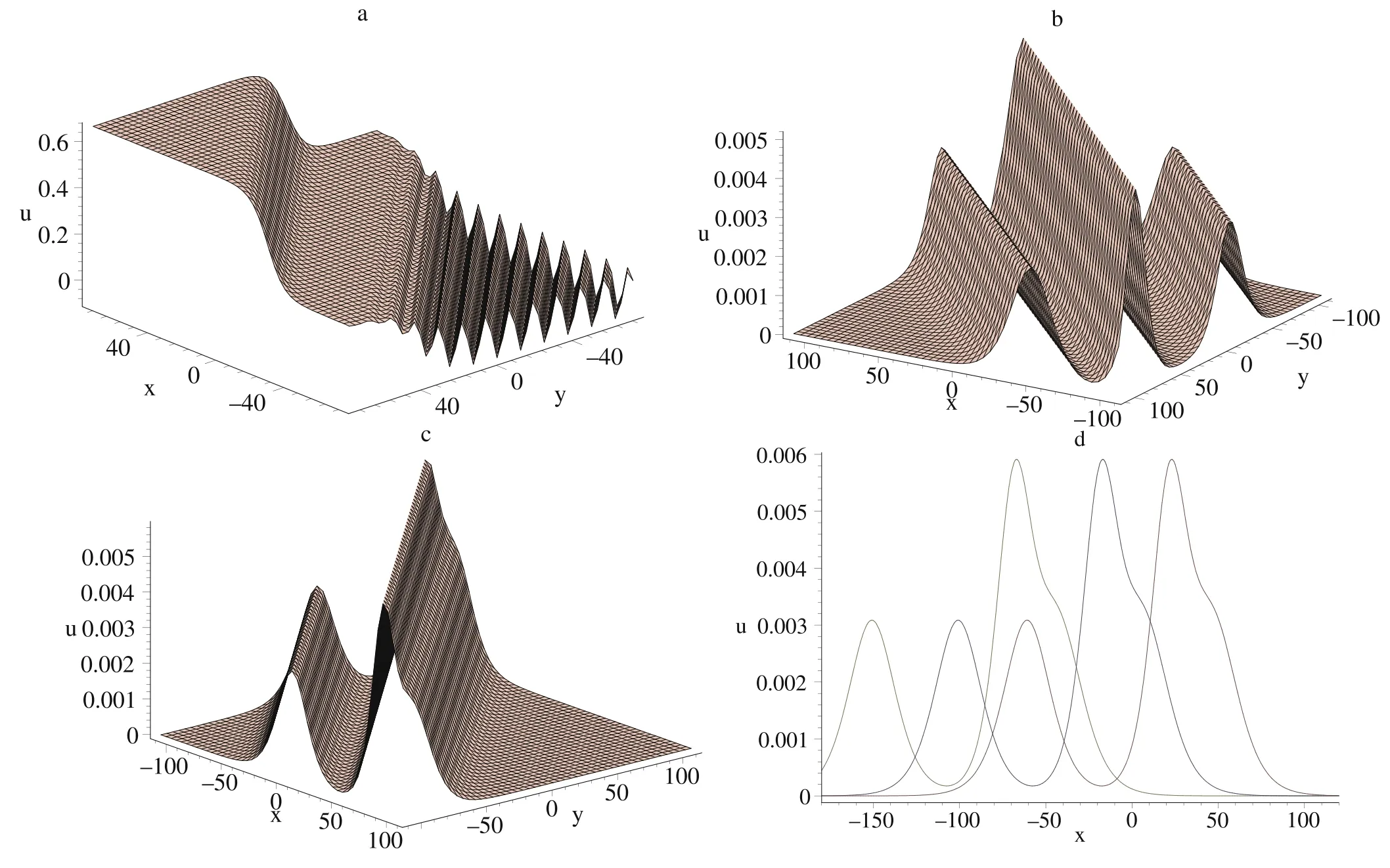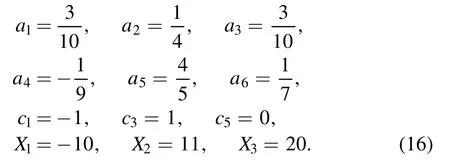Dynamics of a D’Alembert wave and a soliton molecule for an extended BLMP equation
2021-04-12BoRen
Bo Ren
Institute of Nonlinear Science,Shaoxing University,Shaoxing,312000,China
Abstract The D’Alembert solution of the wave motion equation is an important basic formula in linear partial differential theory.The study of the D’Alembert wave is worthy of deep consideration in nonlinear partial differential systems.In this paper,we construct a (2+1)-dimensional extended Boiti–Leon–Manna–Pempinelli (eBLMP) equation which fails to pass the Painlevé property.The D’Alembert-type wave of the eBLMP equation is still obtained by introducing one arbitrary function of the traveling-wave variable.The multi-solitary wave which should satisfy the velocity resonance condition is obtained by solving the Hirota bilinear form of the eBLMP equation.The dynamics of the three-soliton molecule,the three-kink soliton molecule,the soliton molecule bound by an asymmetry soliton and a one-soliton,and the interaction between the half periodic wave and a kink soliton molecule from the eBLMP equation are investigated by selecting appropriate parameters.
Keywords: (2+1)-dimensional extended Boiti–Leon–Manna–Pempinelli equation,Painlevé analysis,D’Alembert waves,soliton molecule
1.Introduction
The D’Alembert solution for the wave motion equation is found by decomposing it into two first-order wave operators.The D’Alembert solution of the wave equation was an early milestone in the development of the linear partial differential equation.The D’Alembert solution,which represents a leftmoving and a right-moving wave,can be treated as the general solution in the wave equation.The D’Alembert solution for the nonlinear partial differential equation is of fundamental interest [1].
In addition,the soliton molecule has triggered interest in several physical areas [2–5].The soliton molecule is considered as the soliton boundary state.It is formed by the balance of attraction and repulsive interaction between solitons [2].Several theoretical approaches have been used to study the soliton molecule [6–8].Recently,the velocity resonance mechanism to extract the soliton molecule has been developed in high-order nonlinear systems [9,10].Many nonlinear integrable systems have been confirmed by the velocity resonance mechanism,such as the fifth-order Korteweg–de Vries (KdV) equation [11,12],the extended modified KdV equation [13],the bidirectional Sawada–Kotera equation [14] and the few-cycle-pulse optical model[15].The interaction between solitons and other complicated waves has been vital in understanding the fundamental structures in nonlinear systems [16–26].Some novel localized waves are derived with the aid of the the homoclinic test approach [24],the Darboux transformation [25] and the long-wave limit method [26].The interaction between soliton molecules and other waves is obtained by combining the Darboux transformation,the variable separation approach and the velocity resonance mechanism [27,28].In general,the study of the soliton molecule is mainly focused on a boundary state which consists of two solitons.In this paper,a (2+1)-dimensional extended Boiti–Leon–Manna–Pempinelli (eBLMP) equation which possesses the D’Alembert solution and the soliton molecule (a boundary state with the three-soliton or three-kink soliton) is constructed.This soliton molecule can be treated as a special D’Alembert wave with some detailed analysis.
The (2+1)-dimensional eBLMP equation reads:

wherec1,c2,c3and c4are arbitrary constants.Equation (1)will reduce to the (2+1)-dimensional BLMP equation withc2=c3=c4=0and the (2+1)-dimensional shallow-water wave equation withc3=c4=0,respectively.The BLMP equation is proposed by a(2+1)-dimensional generalization of the Ablowitz–Kaup–Newell–Segur shallow-water wave equation through the bilinear approach [29].The Jacobi elliptic function solution,quasi-periodic wave solution and mixed lump-soliton solution have been investigated by virtue of different methods [30–32].The dynamics of the lump wave,multi-lump wave and lump–kink wave solutions of the(2+1)-dimensional shallow-water wave equation are found by straight ansatzes and the Hirota bilinear method [33,34].
The present paper is organized as follows.In section 2,the standard Weiss–Tabor–Carnevale (WTC) method is used to solve the (2+1)-dimensional eBLMP equation (1).The eBLMP equation fails to pass the Painlevé property.In section 3,the D’Alembert-type wave of the (2+1)-dimensional eBLMP equation which involves one arbitrary function is obtained by introducing the traveling-wave variable.The solitary waves and the soliton molecules of (1) are found by selecting the concrete arbitrary function.In section 4,the three-kink soliton molecule and the three-soliton molecule of(1)are constructed by the velocity resonance mechanism.The last section concludes with a short summary and some discussions.
2.Painlevé analysis of the (2+1)-dimensional extended BLMP equation
The WTC method is one of most powerful methods used to study nonlinear field models.It can clarify the complete integrability of nonlinear equations.In this section,the standard WTC approach is used to test the Painlevé property of(2+1)-dimensional extended BLMP equation (1) [35].According to the standard WTC method,the fields of u and v read as the following ansatz:

where ujand vjare the arbitrary functions of(x,t) .We get the following results by the leading-order analysis:

Substituting (3) and (2) into (1) and comparing the coefficients ofthe polynomial equation in j reads:

The resonance values of j are:

The resonance at j=−1 corresponds to the arbitrary singularity manifold φ.The model requires a sufficient number of arbitrary functions at other resonance values j=1,2,4,6.After some detailed calculations,other resonance conditions at j=1,2,4,6 are not satisfied.From the aforementioned considerations,we deduce that the eBLMP equation is not a Painlevé integrable system.Although it fails to pass the Painlevé test,many interesting mathematical properties,such as the D’Alembert-type wave and the soliton molecule,can be obtained by introducing the traveling-wave variable and the Hirota bilinear method.
3.D’Alembert-type wave of the (2+1)-dimensional eBLMP equation
To determine the D’Alembert-type wave,the solution of the eBLMP equation assumes:

Substituting (6) into (1) yields:

By solving (8),we get:

Substituting (9) into (7) leads to:

By solving the above ordinary differential equations,the parameters are restricted by the following relations:

The D’Alembert-type wave reads:

with the velocity


Figure 1.(a) The interaction between a half periodic wave and a kink soliton molecule.(b) The three-soliton molecule.(c) The soliton molecule consists of an asymmetry soliton and a one-soliton.(d)Wave propagation pattern of the wave along the x axis at the time t=−20,0,25 (from left to right).
The D’Alembert-type wave (12) includes one arbitrary function.We can get the solitary waves and the soliton molecules by selecting the arbitrary function.Some phenomena are displayed with the concrete arbitrary function.
The interaction between the half periodic wave and the one-kink soliton is studied in the Sharma–Tasso–Olver–Burgers equation [36].While the arbitrary function takes:

the interaction between the half periodic wave and the kink soliton molecule is shown in figure 1(a).The parameters are

and the time t=0.The soliton molecule that consists of the three solitons is plotted by figure 1(b).The three-soliton molecule selects:

with the time t=0 and the parameters

The three-soliton molecule becomes the soliton molecule bound as an asymmetry soliton and one-soliton with the same parameters in (16) and phases X1=12,X2=90,X3=20 by figure 1(c).The evolution of the soliton molecule bound as the asymmetry soliton and one-soliton is displayed in figure 1(d)(from left to right the time t=−20,0,25).The formation of double solitons (soliton molecule) can be built from noise in an ultrafast fibre laser[37].By selecting appropriate parameters,the soliton molecule bound by three solitons,and the soliton molecule bound as an asymmetry soliton and one-soliton are shown in figures 1(b) and (c),respectively.These phenomena are worth further investigation by experiments.
4.Soliton molecule of the(2+1)-dimensional eBLMP equation
To obtain the Hirota bilinear form of the eBLMP equation,the dependent variable transformation is introduced


Figure 2.(a) The three-kink soliton molecule for u.(b) The three-soliton molecule for v.
with the auxiliary function f.By substituting(17)into(1),the bilinear form of the eBLMP equation reads:

whereDx,Dyand Dtare bilinear derivative operators [38]

The multiple solitary wave solution of the eBLMP equation can be calculated as:

By substituting (20) into (18),the dispersion relation should be satisfied:

The soliton molecule can be constructed with the velocity resonance condition.The velocity resonance conditiongives

By solving above the velocity resonant condition,the parameters restrain as the relation:

Relation (23) in the velocity resonant condition has the same expression for (11) in the D’Alembert-type wave.Solution(17) in the soliton molecule is just a special D’Alembert wave.Figures 2(a)–(b) show the three-kink soliton molecule and the three-soliton molecule for fields u and v,respectively.The parameters in figures 2(a)–(b) are:

at the time t=0.
5.Conclusion
In summary,we construct a (2+1)-dimensional eBLMP equation according to the usual (2+1)-dimensional BLMP equation.It fails to pass Painlevé property by the WTC approach.The D’Alembert-type wave and the soliton molecule are still found in the eBLMP equation.The D’Alemberttype wave includes one arbitrary function which can describe the evolution of nonlinear shallow-water wave propagation.By selecting the concrete function,some novel phenomena are shown in figures 1(a)–(d).We find that relation (23) has the same expression both in the velocity resonance condition(11) and in the D’Alembert-type wave.The soliton molecule can thus be treated as a special D’Alembert wave.The threekink soliton molecule and the three-soliton molecule are constructed by the velocity resonance mechanism.The D’Alembert-type wave and the soliton molecules for other nonlinear systems deserve further investigation.
Acknowledgments
This work is supported by the National Natural Science Foundation of China Grant No.11 775 146.
杂志排行
Communications in Theoretical Physics的其它文章
- First-principles study on superconductive properties of compressive strain-engineered cryogenic superconducting heavy metal lead (Pb)
- Majorana–Kondo interplay in a Majorana wire-quantum dot system with ferromagnetic contacts*
- Effect of Zn doping on electronic structure and optical properties zincblende GaN (A DFT+U insight)
- Exploring the influence of microRNA miR-34 on p53 dynamics: a numerical study*
- A new approach for modelling the damped Helmholtz oscillator: applications to plasma physics and electronic circuits
- Coexistence and fluctuations phenomena with Davidson-like potentials in quadrupole–octupole deformed nuclei
